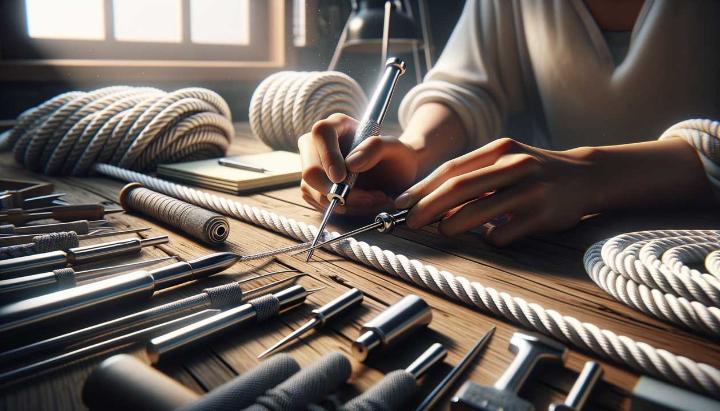Have you ever found yourself in a rope-related predicament, wishing you had the right tools to save the day? Whether you're a seasoned sailor, an adventurous arborist, or an industrial professional, the art of rope splicing can be your secret weapon. But here's the catch: without the proper splicing tool kit, even the most skilled hands can falter.
At iRopes, we've seen firsthand how the right splicing tools can transform a daunting task into a seamless operation. From the sun-drenched decks of yachts to the dizzying heights of tree canopies, our customised rope solutions have conquered challenges across diverse fields. But what really sets apart the pros from the amateurs?
It's all about having an essential rope splicing tool kit for every application. In this guide, we'll unveil the secrets of assembling the perfect kit, exploring everything from the indispensable fid splicing tool to the specialised instruments that cater to unique industry needs. Whether you're splicing ropes for off-road adventures, aerial operations, or industrial applications, we'll show you how to equip yourself for success.
Prepare to dive into the world of professional-grade splicing, where we'll reveal not just the tools, but the techniques that will elevate your rope work to new heights. Are you ready to unlock the power of precision splicing? Let's begin this journey to mastering the art of rope manipulation, one tool at a time.
Types of Splicing Tools and Their Applications
When it comes to rope splicing, having the right tools can make all the difference. As an avid sailor and rope enthusiast, I've learned that different applications require specific splicing tools. Let's dive into the world of splicing tools and explore how they can elevate your rope work.
Fid Splicing Tool and Its Uses
The fid splicing tool is the workhorse of rope splicing. This hollow, needle-like instrument is essential for creating eye splices, end-to-end splices, and working with braided ropes. I remember the first time I used a fid to splice a mooring line - it was like magic watching the rope transform under my hands!
- Material versatility: Fids come in various materials like stainless steel, aluminum, or plastic, each suited for different rope types.
- Size matters: Choose a fid that matches your rope's diameter for optimal results.
- Technique is key: Practice with different fid techniques to master smooth, tight splices.
Other Essential Tools in a Splicing Tool Kit
While the fid is crucial, a well-rounded splicing tool kit includes several other instruments. Here's what you should consider adding to your arsenal:
- Sharp scissors or knife
- Measuring tape
- Whipping twine
Each of these tools plays a vital role in creating professional-grade splices. I've found that investing in quality tools pays off in the long run, both in terms of splice durability and the enjoyment of the process.
Importance of Choosing the Right Tools for Specific Splicing Tasks
Different ropes and applications call for specific tools. For instance, when working with synthetic ropes, you might need a hot knife to prevent fraying. On the other hand, natural fiber ropes often require a marlinspike for separating strands.
Have you ever tried to splice a thick rope with the wrong size fid? It's a frustrating experience that can lead to subpar results. That's why I always stress the importance of matching your tools to the job at hand.
Remember, the right tools not only make your work easier but also ensure the safety and longevity of your splices. Whether you're rigging a sailboat or creating custom ropes for industrial use, choosing the appropriate splicing tools is the first step towards achieving professional-grade results.
Splicing Techniques for Various Applications
As a seasoned rope enthusiast, I've learned that the art of splicing extends far beyond a single technique. The world of rope splicing is as diverse as the industries it serves, with each application demanding its own unique approach. Let's explore the fascinating realm of splicing techniques across different sectors.
Splicing Techniques for Nautical and Marine Applications
In the maritime world, rope splicing is not just a skill; it's a necessity. I remember my first sailing expedition, where I witnessed the importance of a well-spliced rope firsthand. The salty sea air whipped around us as we relied on sturdy splices to keep our vessel secure.
- Eye splices: Essential for creating strong, permanent loops at the end of ropes for mooring lines and halyards.
- Short splices: Used to join two ropes of equal diameter, maintaining nearly full strength.
- Long splices: Ideal for running rigging where a smooth profile is crucial for passing through blocks and pulleys.
These nautical splices require precision and practice. The satisfaction of completing a perfect eye splice, feeling the smooth taper of the rope as it flows through your hands, is unmatched.
Splicing Methods for Arborist and Tree Work
Arborists rely on specialized splicing techniques to ensure safety and efficiency in their high-flying work. The stakes are high when you're dangling from a tree, and your life depends on the integrity of your ropes.

Key splicing methods for arborists include:
- Prusik hitches: These friction hitches are crucial for ascending and descending trees safely.
- End-to-end splices: Used to create endless loops for slings and lanyards, maintaining rope strength.
- Locked brummel splices: Provide a secure attachment point for hardware like carabiners.
Industrial Splicing Techniques for Heavy-Duty Ropes
In the industrial sector, rope splicing takes on a whole new level of complexity. I once visited a mining operation where the sheer scale of the ropes and splices left me in awe. These aren't your everyday ropes; they're massive lifelines that keep operations running smoothly and safely.
- Tucked splices: Used in wire ropes to create eyes or join ropes while maintaining strength.
- Tapered splices: Essential for large diameter synthetic ropes in applications like mooring lines for oil tankers. Learn more about towing ropes used in mining operations.
- Core-to-core splices: Crucial for high-performance ropes in offshore and heavy lifting operations.
Custom Splicing Solutions for Unique Applications
Sometimes, standard splicing techniques just won't cut it. That's when custom solutions come into play. I've had the pleasure of working on some truly unique projects that required thinking outside the box.
Did you know? Custom splicing solutions often combine traditional techniques with modern materials to create innovative, application-specific results.
For instance, I once developed a custom splice for a theme park ride that needed to withstand extreme G-forces while maintaining a smooth, low-profile connection. It involved a hybrid of nautical and industrial techniques, resulting in a splice that was both incredibly strong and virtually invisible to riders.
Whether you're working with high-tech synthetic fibers or traditional natural ropes, mastering these diverse splicing techniques opens up a world of possibilities. Remember, the key to successful splicing lies in understanding the specific requirements of your application and choosing the right technique for the job.
Assembling Your Essential Rope Splicing Tool Kit
As a seasoned rope splicing enthusiast, I've learned that having the right tools at your fingertips can make all the difference between a frustrating experience and a rewarding one. Whether you're rigging a sailboat, setting up tree climbing gear, or working on industrial-grade ropes, a well-assembled splicing tool kit is your ticket to professional-grade results. Let's dive into the essentials you'll need to tackle any splicing job with confidence.
Essential Tools for Rope Splicing
Every rope splicing tool kit should start with these core components:
- Fids: These hollow, needle-like tools are the backbone of any splicing kit. They come in various sizes to match different rope diameters.
- Pushers: Working in tandem with fids, pushers help guide rope strands through tight spaces during the splicing process.
- Tape measure: Precision is key in splicing, and a good tape measure ensures your measurements are spot-on.
- Sharp scissors or knife: Clean cuts are essential for professional-looking splices and prevent fraying. Discover more about choosing the best winch cable.
I remember the first time I used a quality fid and pusher set - it was like night and day compared to my makeshift tools. The smooth, effortless way they glided through the rope strands was a game-changer for my splicing projects.

Choosing the Right Fids and Pushers
When it comes to fids and pushers, size matters. Here's how to select the right ones:
- Match rope diameter: Choose fids that correspond to the diameter of the ropes you commonly work with. A good rule of thumb is to have fids for 1/4", 3/8", 1/2", and 5/8" diameter ropes.
- Consider material: Fids come in aluminum, plastic, and stainless steel. Each has its pros and cons:
- Aluminum: Lightweight and corrosion-resistant, great for marine environments.
- Plastic: Affordable and gentle on synthetic ropes, but less durable.
- Stainless steel: Extremely durable and smooth, ideal for frequent use.
- Kit compatibility: Look for fid and pusher sets from reputable brands like Samson or New England Ropes. These often come in convenient kits with multiple sizes.
Have you ever struggled with a fid that's too big or too small for your rope? It's like trying to thread a needle with a rope - frustrating and ineffective. That's why having the right sizes is crucial for smooth, efficient splicing.
Pro Tip: Invest in a professional rope splicing tool kit if you're serious about your craft. These kits often include a range of fids, pushers, and accessories tailored for various splicing techniques and rope types. Learn more about mastering rope splice techniques.
Remember, a well-assembled rope splicing tool kit is an investment in your craft. By choosing the right tools and taking care of them, you'll be well-equipped to tackle any splicing project that comes your way. Whether you're working on a small DIY project or professional-grade marine rigging, having the right tools at hand will make all the difference in achieving clean, strong, and reliable splices.
Mastering the Art of Rope Splicing: Essential Techniques
Rope splicing is a time-honoured skill that has been essential to sailors, climbers, and craftsmen for centuries. As someone who's spent years perfecting this craft, I can tell you that mastering rope splicing is both a practical necessity and a rewarding art form. Let's dive into the world of rope splicing and explore the techniques that will elevate your rope work to new heights.
Understanding Different Types of Rope Splices
Before we get our hands dirty, it's crucial to understand the different types of splices you'll encounter. Each splice has its unique purpose and application:
- Eye splice: Creates a strong, permanent loop at the end of a rope. I've used this countless times for mooring lines and safety harnesses.
- Short splice: Joins two ropes of equal diameter, maintaining nearly full strength. Perfect for extending ropes without compromising integrity.
- Long splice: Similar to the short splice but maintains the rope's diameter, ideal for running through pulleys.
Choosing the right splice depends on your specific needs. For instance, when I'm rigging sails, I always opt for an eye splice due to its strength and compact profile.

Step-by-Step Guide to Creating a Strong Eye Splice
Let's walk through creating an eye splice, one of the most versatile and useful splices you'll learn:
- Gather your materials: You'll need a three-strand rope, a fid, scissors, and whipping twine.
- Measure and mark: Unlay the rope strands about 12 times the rope's diameter and mark where the eye will begin.
- Form the eye: Bend the rope to form the desired eye size.
- Tuck the strands: Using your fid, tuck each strand under an adjacent strand in the standing part of the rope.
- Continue tucking: Repeat the process, typically 3-5 times, depending on the rope material.
- Taper and trim: Gradually reduce the size of the tucks and trim excess material.
- Whip the splice: For added security, whip the splice with twine.
Remember, practice makes perfect. The first time I attempted an eye splice, it looked more like a bird's nest than a professional finish. But with patience and persistence, you'll soon be creating splices that are both functional and beautiful.
Safety first! Always wear gloves when splicing to protect your hands from rope fibres and potential cuts.
As you progress in your splicing journey, you'll discover that different ropes require different techniques. Synthetic ropes like Dyneema or Spectra often need specialized splicing methods to maintain their incredible strength-to-weight ratio. Don't be afraid to experiment with different materials and techniques – that's how you'll truly master the art of rope splicing.
Have you tried your hand at rope splicing before? What challenges did you face, and how did you overcome them? Share your experiences in the comments below – I'd love to hear about your splicing adventures!
Unlock the Power of Splicing: Essential Tools and Techniques
Having the right rope splicing tool kit is crucial for achieving professional-grade results across various applications, whether for nautical, arborist, or industrial purposes. A fid splicing tool stands out for its versatility, making it essential for many splicing tasks. Your rope splicing tool kit should include a fid, sharp scissors, a tape measure, and additional specialised tools for advanced techniques. Mastering the art of splicing involves practice, understanding different techniques, and maintaining your tools. By investing in quality tools and developing your splicing skills, you'll ensure safety, reliability, and professionalism in every splice. Fill out the form above to learn more about how iRopes can customise a rope splicing tool kit tailored to your specific needs.